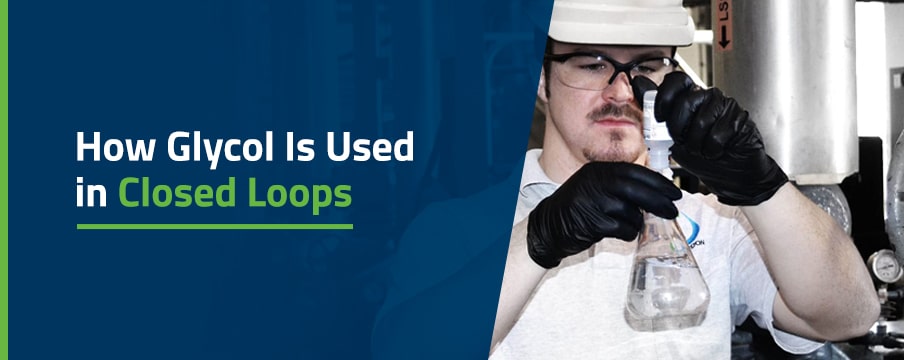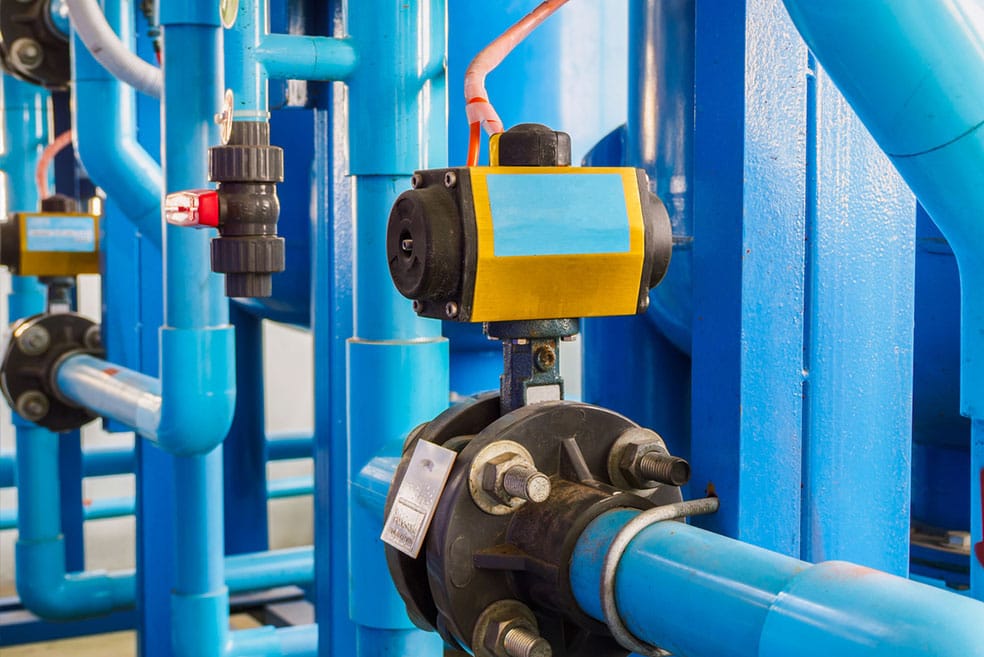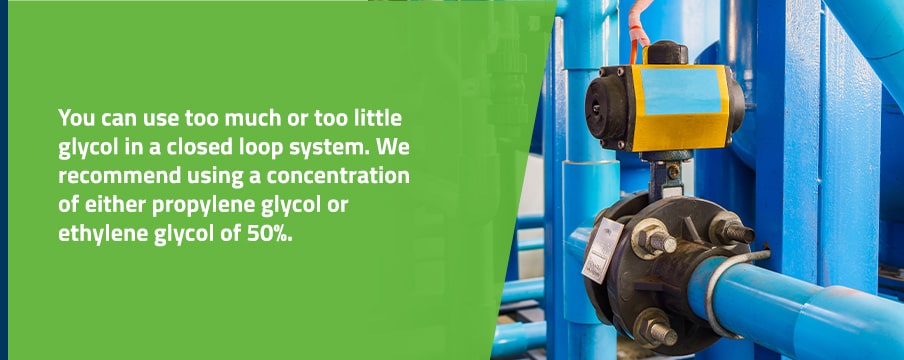
Glycol is a chemical used in closed loop systems to protect water from freezing. It is only one of the chemical treatments applied to water in these systems to prevent problems and extend the efficiency of the system’s cooling ability. Recognizing the importance of glycol and other chemical treatments in these systems starts with understanding how they work.
At Chardon Laboratories, we can create a glycol-based water treatment program to extend the life of commercial boilers and cooling towers. Our team understands glycol and will recommend the correct type and concentration for your system.
For closed loop systems to function properly, the water inside must continuously flow, regardless of external conditions. Areas of the loop exposed to subfreezing temperatures need to incorporate freeze protection by adding glycol. Glycol’s interaction with water reduces the freezing point of the liquid inside the system, so it requires much colder temperatures before the liquid freezes.
In a closed loop system, the water could freeze if exposed to temperatures below 32 degrees Fahrenheit. By adding ethylene glycol to the water to create a 60% solution, the freezing point plummets to minus 60 degrees Fahrenheit.
Glycol has a freezing point of minus 39 degrees Fahrenheit. When mixed with water, the properties of the two combine to create a lower freezing point than either could have individually. This interaction also helps to provide burst and freeze protection for the closed loop system.
The table below illustrates propylene and ethylene glycol’s freezing points at different concentrations.
| Propylene Glycol Volume % | Freezing Point °F | Ethylene Glycol Volume % | Freezing Point °F |
| 4.8 | 29.1 | 4.4 | 28.4 |
| 20.4 | 18.3 | 22.0 | 14.0 |
| 30.4 | 7.9 | 37.5 | -11.2 |
| 40.6 | -7.8 | 45.5 | -27.4 |
| 54.0 | -39.7 | 57.8 | -59.8 |
| 65.0 | <60.0 | 68.3 | <55.0 |
| 75.0 | <60.0 | 73.6 | <55.0 |
| 85.0 | <60.0 | 84.3 | -34.5 |
| 95.0 | <60.0 | 95.0 | -3.0 |
Freezing water expands, causing pipes in a closed system to burst. Adding glycol to the water helps prevent both freezing and bursting, depending on the type of glycol used and its concentration. If running a closed loop in cold climates, you should consider using this antifreeze. It hinders water loss and equipment damage, saving you money and helping you avoid a system shutdown.
Freeze protection prevents the water from freezing, allowing it to continue to flow and preventing system damage. However, burst protection prevents the pipes from breaking if the liquid inside freezes.
As temperatures drop around a closed loop system with a glycol solution during winter, the water will freeze and separate or precipitate out of the mixture. The frozen water makes the glycol solution slushy. If the slush does not last long and has a low viscosity, most systems will stand up well.
While water expands when frozen, glycol reduces in volume. When the temperature drops low enough for glycol to freeze, it will contract, lowering the total solution volume in the pipes and preventing breaks.
In short, glycol in the proper concentration can prevent water freezing and protect the pipes from bursting in the rare instance of a freeze.

Some examples of closed loop chemicals that we use include:
When taking measures to prevent corrosion in a closed loop, simply adding chemicals to a system with chemical buildup or existing corrosion will not suffice. The first step for any treatment of a closed loop system, whether by adding glycol for freeze prevention or incorporating corrosion protection, should be cleaning and flushing the system. The chemicals that protect the interior from corrosion only work when applied to clean surfaces.
You can use pre-commission cleaners and flushers to remove oil, flux residue, grease and corrosion deposits. Regular cleaning can optimize operational efficiency and control Legionella growth in cooling towers.
In systems that contain galvanized steel or aluminum, glycol solutions can cause localized corrosion. Specialty Dow-inhibited glycol solutions already contain corrosion inhibitors and don’t need additional products. However, green-colored glycol products may benefit from adding SN solutions to prevent corrosion.
Automatically adding fresh water presents potential problems for systems that use glycol. By not regulating the amount of water added, the glycol solution could dilute too much to provide adequate freeze or burst protection. To mitigate the problem of creating unknown concentrations of glycol, either use a glycol feed system or a water meter.
Using the incorrect glycol volume can freeze pipes in closed loop systems. The expansion tanks should have a 4% higher volume of water when used with a system that contains glycol than one that does not use this chemical.
Other potential issues include:

You can use too much or too little glycol in a closed loop system. We recommend using a 50% concentration of either propylene or ethylene glycol to ensure freeze protection down to minus 25 degrees Fahrenheit. Using too much glycol reduces the amount of heat the system can hold, thereby decreasing efficiency and increasing energy costs as the closed loop system struggles to properly cool or heat.
To determine the concentration and freeze protection level of glycol in your closed loop, use a refractometer. This device measures glycol’s light refraction index. High glycol concentration levels cause greater refraction.
Here’s how to test glycol with a refractometer:
The time between replacing the glycol in a closed loop system relies on several variables. For instance, heated systems that frequently exceed 250 degrees Fahrenheit may experience a more regular breakdown of the glycol, requiring more frequent changes. The same increase in replacement frequency happens in systems that have contamination.
For uncontaminated systems that are truly closed loop in design and do not require makeup water, the glycol could last three to five years. Systems in cold climates may require more regular maintenance than warmer ones. Frequent maintenance is vital as it prevents freezing during winter.
The best way to determine when to replace glycol comes from regularly testing the pH, ammonia, copper and iron levels in the liquid. As glycol breaks down, it turns into glycolic acid, lowering pH and potentially leaching metals or ammonia into the solution.
Look out for these signs to determine when to replace glycol:
Common types of glycol used in closed loop systems include propylene and ethylene glycol. Ethylene glycol is ideal for low-temperature areas and applications requiring high thermal performance. In contrast, propylene suits low thermal performance operations. These chemicals also have variations based on the presence of inhibitors or other additives.
At Chardon Labs, we commonly use the following:
While automotive antifreeze, which is bright green, technically contains glycol, it is not ideal for a closed loop system. This product contains silicates, which can negatively impact heat transfer. Additionally, the coloring makes most water chemistry tests impossible to interpret. Avoid this type of product in closed loop systems. Only use ethylene or propylene glycol.
Ethylene glycol is most commonly used for closed loop system freeze protection because it has a considerably low freezing point and can contract when it freezes. It supports heating, cooling, ventilation and gas compressing systems. However, for any systems that process food, ethylene glycol is unsuitable due to its toxicity.
Propylene glycol is environmentally friendly because it doesn’t leave harmful substances after breaking down. It is also less toxic and acceptable in pharmaceuticals, cosmetics, food and beverage and other industries that require low-risk exposure. However, it has a high freezing point and does not provide burst protection. According to the Centers for Disease Control and Prevention (CDC), propylene and ethylene glycol break down at the same rate.
The table below summarizes the differences between the two glycol types.
| Component | Ethylene Glycol | Propylene Glycol |
| Applications | Supports more applications due to its high heat transfer property | Considerably few applications require propylene’s low heat transfer capability |
| Viscosity | Less viscous than propylene at sub-zero temperatures | More viscous at low temperatures and requires more energy to run |
| Cost | Due to its popularity, ethylene is manufactured in larger volumes, bringing its cost down | Propylene is available in lower volumes, making it more expensive than ethylene |
| Toxicity | Toxic to humans and animals | Relatively safe for humans and animals |
| Freeze point protection | A smaller percentage volume of ethylene is required to provide freeze protection | A higher percentage volume of propylene is required to attain the same freeze point protection as ethylene |
Click here for the part 2 article on glycol in closed loop systems.
Don’t just buy chemicals. Purchase clean systems from Chardon Labs. Our technically proficient teams, trustworthy expertise and cost-effective solutions help facilities maintain clean and efficient systems.
For more information about how we go beyond selling chemicals to providing ways of keeping systems clean, contact us online. Our water treatment experts will answer your questions on how glycol is used in closed loops and recommend suitable solutions.